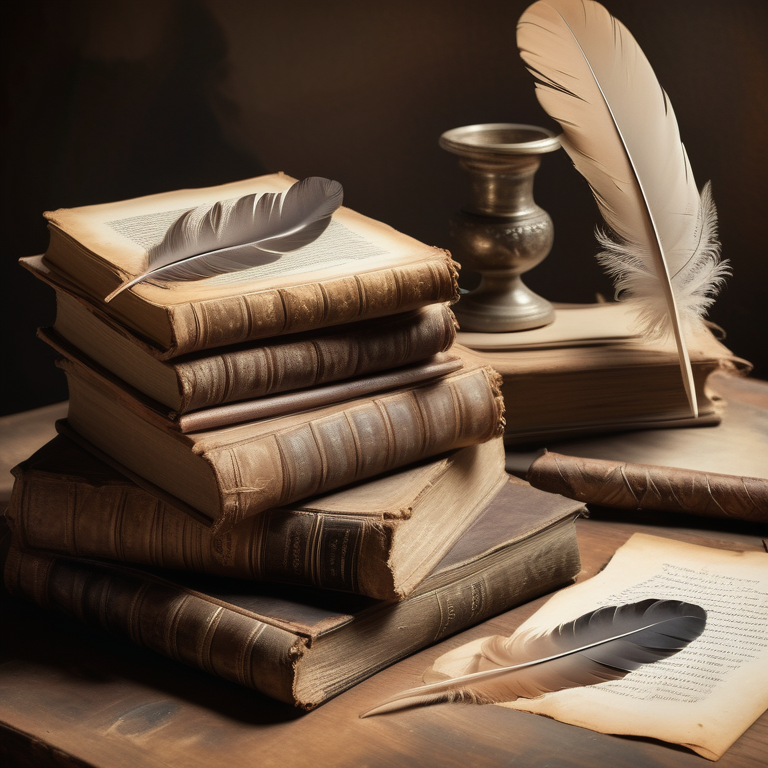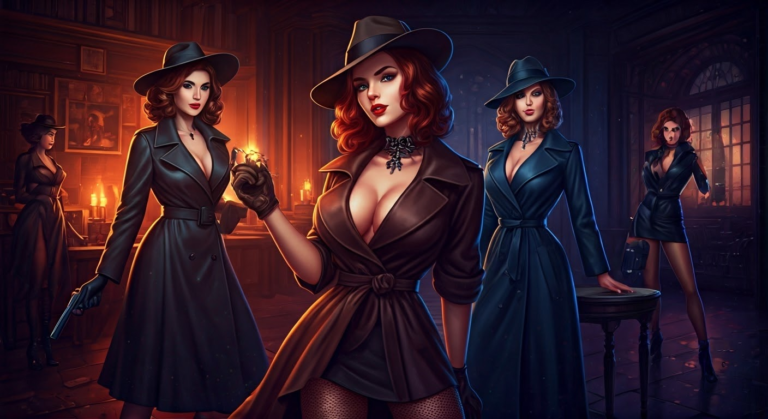Historical Perspectives in Books on Female Sexuality

Key Highlights
- Explore the evolution of female sexuality in literature, from ancient texts to contemporary discussions.
- Learn about key historical figures and writers who challenged societal norms regarding female sexuality.
- Discover how themes of love, power, and autonomy are portrayed in books on female sexuality.
- Analyze the impact of literature on modern understandings of female sexuality and societal attitudes.
- Understand the role of literature in shaping public perception and empowering women through feminist literature.
Introduction
In the realm of literature, the exploration of female sexuality has been a subject of profound intrigue and evolution. Understanding the historical perspectives presented in books on female sexuality offers a gateway to comprehend societal attitudes, taboos, and advancements throughout different eras. From ancient texts with varied interpretations to the restrictive roles in the Middle Ages, each period reflects a tapestry of beliefs and norms. Key historical figures, including writers who challenged the status quo and feminist authors, have significantly influenced the discourse on women’s sexuality. As we delve deeper into the Victorian era to the 20th century, an evident shift in narratives and the introduction of psychoanalytic theories shaped discussions on this intricate topic. This introductory journey sets the stage for a nuanced exploration of how literature has portrayed and impacted female sexuality over time.
The Evolution of Female Sexuality in Literature
Throughout history, the portrayal of female sexuality in literature has evolved significantly. Ancient texts often depicted women’s sexuality through the lens of mythology, emphasizing fertility and motherhood. In the Middle Ages, societal restrictions constrained the exploration of female desire, relegating women to predefined roles within the patriarchal structure. However, the Renaissance period witnessed a gradual shift towards more nuanced representations of women’s sexual autonomy and agency in literature, challenging traditional norms. As the feminist movement gained momentum, female authors began to assert their voices, injecting themes of sexual liberation and empowerment into their works. These shifts in narrative reflect the evolving attitudes towards women’s sexuality and serve as a testament to the ongoing dialogue surrounding gender, arousal, desire, and empowerment in literature.
Ancient Texts and Interpretations
In ancient texts, depictions of women’s sexuality varied widely, influenced by cultural norms and values. From the Kama Sutra’s detailed exploration of female pleasure to the often repressive views in religious scriptures, interpretations of female sexuality were deeply embedded in societal beliefs. Ancient philosophers like Plato and Aristotle debated the role of women in sexuality and society, shaping early perceptions of female desire and behavior. These texts laid foundational understandings of women’s sexuality that reverberate through history, influencing later works and societal attitudes towards female sexual autonomy and pleasure. The rich tapestry of ancient texts provides valuable insights into the complexities of gender dynamics and sexual norms in different civilizations, offering a window into the past that informs contemporary discussions on women’s sexuality.
The Middle Ages: Restrictions and Roles
During the Middle Ages, society imposed rigid restrictions on female sexuality, largely influenced by religious beliefs and societal norms. Women were often relegated to traditional roles as wives and mothers, with little autonomy over their own sexual desires or behaviors. Any deviation from the prescribed norms was met with severe consequences, including ostracization and even punishment. The concept of female pleasure was largely ignored or deemed sinful, contributing to a culture of repression and control. Women’s sexuality was closely tied to notions of purity and chastity, reinforcing the idea that their worth was dependent on their adherence to these restrictive standards. The Middle Ages, therefore, represented a period marked by limited sexual agency and the enforcement of stringent gender roles.
Key Historical Figures and Their Contributions
Throughout history, numerous key historical figures have made significant contributions to the portrayal and exploration of female sexuality in literature. Writers such as Virginia Woolf and Anais Nin challenged societal norms and taboos, offering a deeper understanding of women’s desires and struggles. Their works provided a platform for feminist discourse and introspection on sexual autonomy and gender dynamics. Additionally, pioneers like Simone de Beauvoir and Audre Lorde delved into complex themes of identity, power dynamics, and the intersectionality of female experiences. These influential figures not only shaped the literary landscape but also played a crucial role in advancing conversations around women’s sexuality and empowerment.
Writers Who Challenged the Status Quo
In exploring historical perspectives on female sexuality, it is vital to acknowledge writers who fearlessly challenged societal norms. Authors such as Virginia Woolf and Anais Nin delved deep into the complexities of women’s desires, paving the way for more open discussions on female sexuality. Their works not only confronted taboos but also advocated for women’s sexual agency and autonomy. By pushing boundaries and defying conventions, these writers reshaped the narrative surrounding women’s sexuality, inspiring a generation to embrace their sexual identities without shame or restraint. Their bold narratives continue to influence modern discourse on female sexuality, highlighting the enduring impact of their revolutionary contributions.
Feminist Authors and Their Impact
Feminist authors have significantly shaped the discourse on female sexuality, challenging traditional norms and advocating for gender equality in literature. Writers like Audre Lorde and bell hooks have explored themes of sexual liberation, body autonomy, and the intersectionality of gender and race. By addressing issues such as sexual pleasure, sexual desire, and reproductive rights, these authors have empowered women to embrace their sexual identities and navigate complex societal expectations. Their work not only highlights the importance of women’s voices in discussions on sexuality but also contributes to the broader feminist movement by challenging stereotypes and promoting inclusivity and diversity in narratives surrounding women’s experiences. Through their impactful writings, feminist authors continue to influence and inspire readers to engage critically with prevailing attitudes towards women’s sexuality.
The Victorian Era to the 20th Century
The Victorian era marked a significant shift in the portrayal of female sexuality in literature. Society’s rigid moral codes and emphasis on modesty heavily influenced the depiction of women in books during this period. Female characters were often constrained by societal expectations and faced severe consequences for deviating from established norms. However, as the world transitioned into the 20th century, there was a gradual loosening of sexual taboos in literature. Authors began to explore themes of female desire and agency more openly, reflecting the changing attitudes towards women’s rights and autonomy. The emergence of psychoanalytic theories further delved into the complexities of human sexuality, challenging traditional views and paving the way for more nuanced representations of women’s sexual experiences.
Changing Narratives and Social Attitudes
During the Victorian Era and into the 20th century, books on female sexuality underwent a transformation reflecting changing societal norms and attitudes. Literature began to challenge traditional views on women’s roles and desires, gradually embracing more open discussions on sexual matters. Authors delicately navigated societal taboos to shed light on previously suppressed topics like sexual pleasure and desires, giving voice to female characters with agency over their own bodies and desires. This shift in narratives not only mirrored but also influenced the evolving social attitudes towards women’s sexuality, contributing to a broader acceptance of diverse sexual experiences and orientations. The exploration of female sexuality in literature played a pivotal role in reshaping societal norms and promoting a more inclusive and empowering view of women’s sexual autonomy and desires.
The Introduction of Psychoanalytic Theories
Sigmund Freud, a pivotal figure in the field of psychology, introduced psychoanalytic theories that significantly impacted the understanding of female sexuality in literature. Freud’s exploration of the unconscious mind and its influence on behavior shed light on previously uncharted territories. His concepts of the Oedipus complex, libido, and psychosexual development provided a new lens through which authors could analyze and portray female characters. These theories highlighted the intricate connections between early childhood experiences, sexual desires, and adult behaviors, reflecting a deeper complexity in the portrayal of women’s sexuality in books. Freud’s work opened up discussions on female sexual identity, repression, and the subconscious forces shaping sexual behavior, contributing to a more nuanced representation of female sexuality in literature.
The Sexual Revolution and Its Reflection in Literature
The Sexual Revolution in the 1960s sparked a monumental shift in societal attitudes towards sexuality, profoundly impacting literature. Authors began to explore female sexuality more openly, challenging conventional norms and taboos. Books during this period delved into themes of sexual liberation, expression, and empowerment, reflecting the changing dynamics in relationships and desires. The exploration of female sexual pleasure, sexual desire, and autonomy took center stage in many literary works, providing a platform for discussions on sexual health and intimacy. The influences of the Sexual Revolution continue to reverberate in contemporary literature, shaping our understanding of women’s sexuality and the complexities surrounding it.
Breaking Taboos: The 1960s and Beyond
In the turbulent era of the 1960s and beyond, literature on female sexuality began to challenge societal norms and break long-standing taboos. Authors and thinkers pushed boundaries by exploring themes of sexual liberation, women’s empowerment, and sexual autonomy. The sexual revolution of this period sparked a wave of progressive ideas and narratives centered around female pleasure and desire. Books on female sexuality delved into previously forbidden topics, openly addressing female orgasm, sexual orientation, and intimate relationships. These provocative works played a vital role in reshaping public perceptions and dismantling traditional restrictions on women’s sexuality. Through their courageous writing, authors contributed significantly to the ongoing discourse on gender equality and sexual freedom. The 1960s marked a turning point in the history of literature on female sexuality, paving the way for more transparent and inclusive discussions in the decades that followed.
Contemporary Discussions on Female Sexuality
In contemporary discussions on female sexuality, there is a notable shift towards inclusivity and diversity, exploring various aspects beyond traditional norms. Authors delve into themes like sexual orientation, sexual health, and female orgasm with a nuanced approach. These discussions are no longer confined to societal taboos but openly address sexual desire, sexual pleasure, and women’s autonomy in sexual behavior. The representation of different perspectives on intimacy, body image, and sexual function reflects the evolving understanding of women’s sexuality in modern literature. Through engaging narratives on sexual desire disorder, gender differences, and the feminist movement, contemporary books on female sexuality offer readers a platform to explore and validate a wide range of experiences and identities.
Themes and Motifs in Books on Female Sexuality
Exploring themes and motifs in books on female sexuality unveils a rich tapestry of exploration and discovery. Authors delve into topics like sexual pleasure, power dynamics, and the quest for autonomy. These literary works often navigate the complexities of repression, liberation, and the formation of identity in the context of women’s sexuality. Love and desire are recurrent motifs, intertwined with discussions on sexual behavior and the female orgasm. Through the lens of literature, readers encounter a diverse array of perspectives on intimacy, gender roles, and the impact of societal norms on sexual expression. Such themes not only reflect historical attitudes towards women’s sexuality but also serve as a lens to analyze broader societal changes and perceptions.
Love, Power, and Autonomy
Literature on female sexuality often delves into the intertwined themes of love, power, and autonomy, reflecting the complexities of women’s experiences. Exploring these themes illuminates the diverse facets of sexual desire and expression, shaping societal norms and personal identities. Within the context of female sexuality, narratives frequently navigate the dynamics of intimacy, agency, and self-discovery. Understanding the interplay of love, power, and autonomy in literary works not only offers insights into individual experiences but also contributes to broader discussions on gender dynamics and social structures. Authors leverage these themes to challenge conventional boundaries and empower women to embrace their desires and assert their autonomy in relationships and society at large. This nuanced exploration highlights the multifaceted nature of women’s sexuality and the evolving perceptions surrounding it.
Repression, Liberation, and Identity
In exploring the theme of repression, liberation, and identity in books on female sexuality, it is essential to delve into how historical narratives have shaped societal norms and individual experiences. Throughout history, women’s sexuality has been subject to various forms of repression, whether through societal restrictions or cultural taboos. However, literature has also been a powerful tool for liberation, providing a platform for women to express their desires and assert their identities. By examining the intersection of sexuality and identity in literature, we can gain a deeper understanding of how these themes have evolved over time, reflecting changing attitudes towards female empowerment and sexual autonomy. This exploration highlights the complexities of navigating societal expectations while striving for sexual liberation and establishing a sense of self amidst cultural constraints.
Analyzing the Impact of Literature on Modern Understandings
Literature plays a pivotal role in shaping modern understandings of female sexuality by delving into nuanced themes and perspectives. Through evocative narratives and deep introspections, books on female sexuality have contributed significantly to public perceptions. They serve as a mirror reflecting societal norms, prejudices, and evolving attitudes towards sexual pleasure and gender dynamics. Authors often explore complex topics such as sexual desire, orgasm, and empowerment, giving voice to experiences that challenge traditional views. By dissecting intimate aspects of women’s sexuality, literature not only educates but also empowers readers to question stereotypes and embrace diverse expressions of desire and autonomy. The influence of these written works extends beyond mere entertainment, sparking conversations and fostering a deeper understanding of the multifaceted nature of female sexuality.
How Books Have Shaped Public Perception
Books on female sexuality have played a pivotal role in shaping public perception over the centuries. Through literature, societal attitudes towards women’s sexuality have been both reflected and challenged. Authors have used their works to initiate important discussions on sexual pleasure, intimacy, and gender differences. By exploring themes like desire, sexual health, and reproduction in books, readers have gained a deeper understanding of women’s sexual experiences. These books have not only influenced individual perspectives but have also contributed to larger conversations about sexuality and empowerment in society. The impact of literature in shaping public perception of female sexuality cannot be overstated, as it continues to spark dialogue and foster greater awareness on these crucial issues.
Literature as a Tool for Empowerment
Literature serves as a powerful tool for empowerment, offering diverse narratives that validate and inspire individuals. Books on female sexuality play a crucial role in this journey, reshaping societal norms and fostering self-discovery. By exploring themes of sexual pleasure, identity, and autonomy, these literary works provide a platform for women to navigate complex aspects of their sexuality. Through the lens of female authors and characters, readers can find solace, courage, and understanding in their own experiences. By delving into topics like sexual desire and liberation, literature not only educates but also empowers individuals to embrace their sexuality confidently. This literary empowerment transcends pages, influencing perceptions and advocating for the recognition of women’s sexual agency in society.
Conclusion
Throughout history, books on female sexuality have been integral in shaping societal attitudes and perceptions. From ancient texts to contemporary discussions, literature has played a crucial role in exploring themes of love, power, autonomy, repression, liberation, and identity. These narratives not only reflect the evolution of female sexuality but also challenge cultural norms and empower individuals. By analyzing the impact of these works, we understand how literature has influenced modern understandings of sexuality and gender dynamics. Books have served as a tool for empowerment, providing a platform for diverse voices to be heard and understood. With each page turned, readers delve deeper into the complexities of women’s sexuality, enriching their understanding and promoting a more inclusive and enlightened society.
Frequently Asked Questions
What are the most influential books on female sexuality?
Exploring influential books on female sexuality delves into classics like “The Second Sex” by Simone de Beauvoir, “The Vagina Monologues” by Eve Ensler, and “Fear of Flying” by Erica Jong. These works spark conversations on empowerment, liberation, and identity.
How have perceptions of female sexuality changed over time?
Ancient texts depicted female sexuality differently from the Middle Ages with imposed restrictions. Writers challenged norms, leading to feminist authors shaping modern views. The Victorian era saw evolving narratives, and the sexual revolution broke taboos, influencing contemporary discussions on female sexuality.
Can literature influence societal attitudes towards female sexuality?
Through compelling narratives and diverse perspectives, literature has the power to challenge norms and shape societal views on female sexuality. Authors have sparked conversations, debunked stereotypes, and advocated for empowerment, impacting how society perceives and embraces female sexuality.
What future trends can we anticipate in literature about female sexuality?
Exploring future trends in literature on female sexuality may reveal themes like gender fluidity, intersectionality, and marginalized voices gaining prominence. Expect narratives challenging norms and offering diverse perspectives on empowerment and sexual identity.





